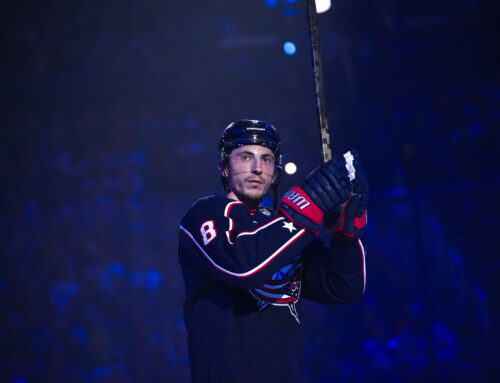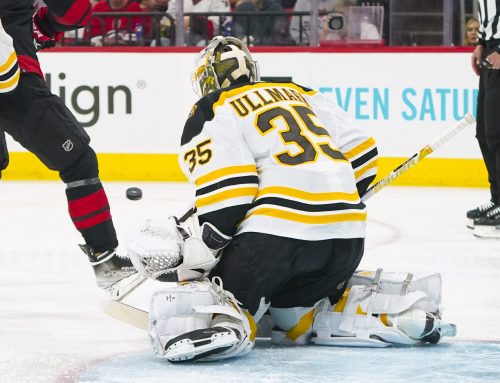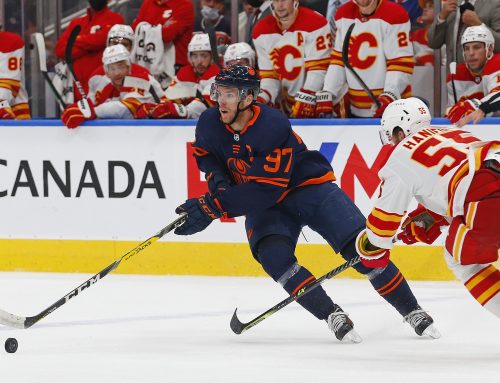
Doing articles like this is really, really hard. My initial list I had cut to 19 players, and then down to 15 players. Once I got to 15, I had nearly an impossible task cutting it down to just 10. At a certain point, you’re just nit-picking small things, like not enough 50-point seasons from a defenceman (which is really hard!) or not 90 hits from a forward instead of 120. And the players you’re cutting are multi-all-star-game-type players. Basically, it’s a nightmare, but it’s fun to look back all the same. I also only used seasons 2010-11 until now, and went a 3:2 ratio for forwards and defencemen, just like real life.
I believe there’s a clear-cut number-1 and then after that, is the best ranking I could do. Feel free to argue with them.
Most data from Evolving Hockey and you can read the other top-10 lists (winger, defenceman, etc) here.
*
Don't forget to pre-order your copy of the mid-season guide today in the Dobber Shop right now!
*
This was a guy I didn’t expect to find on this list once I started narrowing things down but honestly, it’s hard to discount what he did. It came down to this: there were just two guys with at least two seasons of 30 goals, 30 assists, 300 shots, and 100 hits, and they were Pacioretty and Ovechkin (the other guys to do it once were Steven Stamkos and James Neal in 2011-12). When we consider blocked shots, and add at least 30 to the mentioned criteria, Pacioretty is the only player to have accomplished said feat, and he did it twice. It’s really quite incredible what he did for so many years while playing without a number-1 centre, and sometimes a number-2 centre.
I’ve extolled the virtues of the other defencemen in this thread and they’ve all tangentially related to Karlsson. He may not have the 200-hit seasons the Byfuglien does, but he does have several 100 block seasons, something Byfuglien didn’t accomplish until very recently. Values can come from different spots.
The only reason Karlsson finds himself as far down the list as he does was so many seasons with terrible plus/minus ratings. I know they’re not his fault, but there are seasons of minus-30, minus-25, and minus-15 in here. Fantasy leagues of late have (very rightly) started to move away from plus/minus as a stat, but those leagues were very relevant even as recently as a couple years ago when he was minus-25.
8. Milan Lucic
I know he’s a favourite punching bag these days, but basically up until last year, Lucic was at least rosterable in fantasy, and at his best, was an absolute monster multi-cat guy. Consider that there were three forwards this decade with multiple seasons of 20 goals, 30 assists, 140 shots, and 200 hits, and they were Backes (4), Ovechkin (3), and Lucic (2). If we lower the threshold to 20 assists, those three guys remain the only three with at least three such seasons this decade, and one of them for Lucic came in 2016-17 with Edmonton. When Lucic was at his best, we were seeing 25-30 goals, 60-65 points, 200 hits, 100 PIMs, and double-digit PPPs. It’s been some time since he’s been that guy, but even in Edmonton we saw flashes of what once was.
As mentioned earlier, Burns wasn’t always a defenceman with San Jose, and he didn’t shoot nearly as much earlier on, but he had a five-year stretch of absolute dominance: from 2014-19, Burns had five straight years of at least 12 goals, 40 assists, 30 PIMs, 24 PPPs, 240 shots, 100 blocks, and 60 hits. No other defenceman had more than two (Erik Karlsson), and the others to do it just once are Seth Jones and Roman Josi. Just one season like that could see a defenceman be a top-10 option at their position, depending how other categories break down. Burns did it five years in a row. It’s absurd.
In a Ramblings recently, I talked about how David Backes’ 2010-11 season helped me to my first fantasy title, and it’s worth going back over how good he was for so long. Even his 2017-18 season, when it was certain he was in decline and was injured, saw him post an 82-game pace of 20 goals, 27 assists, 76 penalty minutes, 197 hits, and 230 shots over 57 games. He had one bad year in our sample (2018-19) and while it certainly looks like he’s reaching the end of the road of his career, he was elite in fantasy multi-cat leagues for a long time.
Where Backes drew a lot of his value was how monstrous his hits/PIMs totals were, and how he could complement with a healthy amount of points. Remember how great Tom Wilson’s year of 20 goals and 200 hits was in last year? Backes had six seasons of those levels, and in four of those seasons, he added at least 30 assists, at least 90 penalty minutes, and at least 15 power-play points. It was truly a smörgåsbord of fantasy production across the, erm, board. He was better earlier in the decade than he was late in the decade, which is why he is where he is.
Some may clamour for Brent Burns here – he’ll be on the list later – but he wasn’t a regular defenceman putting up monster numbers until 2014-15. Weber’s been there the whole time.
For the decade, there was one defenceman who managed at least three separate seasons of 10 goals, 20 assists, 100 hits, 100 blocks, and 200 shots. That man is Montreal’s current captain. Now, all those seasons happened back when he was with Nashville, but as long as he stays healthy, he’ll hit those marks this year (he has 12-19-73-64-115 as of Tuesday afternoon). He was a model of elite consistency in Nashville, and has maintained that level of production in Montreal, it was just one season where he missed over half the team’s games that kills his decade-long value. Even the season when he played just 58 games, he was a top-24 defenceman in Yahoo! multi-cat leagues. He’s the level we all hope these young goal-scoring defencemen like Nurse, Dumba, and Ekblad can achieve someday.
Thinking back to the start of the decade, remember Landeskog’s rookie year when he busted on the scene for 22 goals, 52 points, and over 200 hits? As a teenage rookie! What a debut.
There was only one real bad year for Landeskog and it was *that* year in Colorado. Safe to say that was a blip, as he has 68 goals, 152 points, 484 shots, and 322 hits in the 174 games since.
Remember back to the threshold for Ovechkin and Benn. Now that we’re moving down the list, let’s lower that threshold. Let’s go to 20 goals, 30 assists, 164 shots (two per game), 30 PIMs, and 100 hits. Landeskog had six such seasons, as did Jamie Benn. Those two tied for the most. So, if we lower our threshold to include guys who may not shoot as much, thus focusing on other peripheral stats, Landeskog was one of the most consistent of the decade. Consider that in those six seasons, Landeskog averaged over 60 penalty minutes per season, and we get a player who was very good for many years all decade long.
It’s always weird to write about a player as one of the best of the decade when he’s been struggling basically for a season and a half now, but it’s easy to forget how outright dominant Benn was in multi-cat leagues right up until 2018. Basically, when I was reviewing the multi-cat seasons, there were two names who kept standing out regardless of the criteria, one was the guy at number-1, the other was Benn. He had four 30-30 seasons with 240 shots and 100 hits.
Benn basically took the mantle from Jarome Iginla for the modern power forward. A guy who can not only lay the body and throw hands, but a guy who can fill the net, and quite literally in both cases, lead the league in points. Now it’s just a wonder if Benn will manage to avoid Iginla’s path and win a Stanley Cup.
Initially, I had Byfuglien on this list lower than Weber, and the basic reasoning was that he had mostly been more injured than Weber. Until I looked at actual games played from 2010-19, and they were virtually tied (within four games of each other). I know Byfuglien was a punching bag at times among fantasy analysts, but the guy was an absolute monster.
At his best, I’m not sure there was a better player to own in fantasy outside of Ovechkin, but Byfuglien is close. He had a four-year stretch where he averaged: 17 goals, 33 assists, 112 PIMs, 18 PPPs, 205 hits, and 92 blocks per season. Those are just disgusting multi-cat numbers for one year, let alone an average for four years. When we look at a lower threshold of 10 goals, 20 assists, 200 shots, and 100 hits, Byfuglien had six such seasons this decade and no other defenceman had more than three.
I don’t think there should be any doubt as to who tops this list. Looking over the data set, there were two guys who had at least four separate seasons of 30 goals, 30 assists, 100 hits, and 240 shots (roughly three per game). We already saw one (Benn), this is the other. As an added bonus, they had at least 30 penalty minutes in each of those campaigns.
When you go over an entire decade, you’ll catch some guys tailing off at different points, as maintaining elite play for 10 years is incredibly hard to do in the NHL. That of those four seasons, one came in the first year of our set and the other three in the latter half tells us that Ovechkin has been dominant all decade long. Not that you guys needed to be told that, but if someone draft Ovechkin in their keeper league in 2009, I don’t think they’re disappointed with the results.





 MTL
MTL
 PIT
PIT FLA
FLA S.J
S.J CGY
CGY MIN
MIN L.A
L.A
